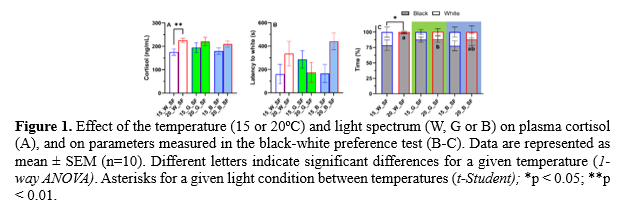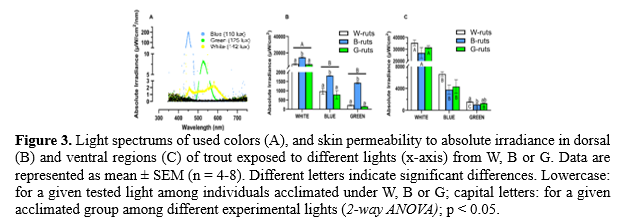LIGHT SPECTRUM, TEMPERATURE AND FEEDING REGIME EFFECT ON RAINBOW TROUT Oncorhynchus mykiss: WELFARE AND PHYSIOLOGICAL RESPONSES
Introduction
Rainbow trout (O. mykiss ) production in Europe accounts for approximately 20% of global production, making it the most farmed freshwater species. To optimize both economic efficiency and animal welfare, three key parameters were studied: temperature, light spectrum, and feeding regime. T emperature is a crucial factor affecting fish metabolism, growth, respiration, stress, and reproduction 1 . Light spectrum, as previous studies indicate that blue and green wavelengths can optimize growth performance in some teleosts 2,3 . Feeding regime is another vital parameter. A fixed feeding schedule that allows fish to anticipate food arrival, can impact growth and metabolism 4. Proper feeding practices ensure that the fish receive adequate nutrition and maintain optimal health.
Materials and methods
Juvenil e trout (3,7±0,3 g weight and 6,7±0,2 cm length) were homogene ously distributed into eight independent experimental groups by duplicates , with different rearing conditions by combining different temperatures (15 or 20ºC), light spectrum [white 380-750nm (W); green 495-570nm (G); or blue 450-494nm (B)] and feeding regime (SF or RF, scheduled or random feedings, limited to white light and at 15ºC) . T he following experimental groups were established: 15_W_SF; 20_W_SF; 15_G_SF ; 20_G_SF; 15_B_SF; 20_B_SF; 15_W_RF; 20_W_RF. During the experimental period, fish were reared under a 12D: 12L photoperiod and daily fed at 3% of body weight . A fter 35 d ays, black-white preference tests were performed to assess anxiety-like behavior and blood samples were taken to measure cortisol. At the end of the experimental period (45 days), ten fish per treatment were euthanized with a lethal dose of MS-222 (400 mg/L) to collect hypothalamus and liver for RNAseq analysis focusing on genes related to stress, energy balance and photoreception. In addition, another group of fish for each treatment was sacrificed during a 24-hour period (every 4 hours) to sample blood, hypothalamus, pituitary and head kidney to measure cortisol and clock gene expression daily rhythms. Lastly, ex vivo skin explants from dorsal and ventral regions were examined to assess permeability to absolute irradiance (EI) with a spectroradiometer.
Results and discussion
Temperature was the only condition that significantly increased plasma cortisol levels (Figs. 1A, 2A). This effect was not observed in fish reared under G or B lights, or under W light between SF or RF, possibly due to already elevated basal cortisol levels. Overall, fish exposed to 20ºC tend to exhibit longer latency to enter the aversive white area in the black-white preference tests and spend less time in it (Figs. 1B,C and 2B,C) , suggesting increased anxiety under such conditions . Interestingly , at 20ºC, time spent in the aversive white area was diminished in fish under G compared to W; B presented intermediated values (Figs 1C). Remarkably, G light and RF condition did not highlight differences between 15 and 20ºC indicating already heightened anxiety. W e confirmed the lights spectrum (Fig. 3A) and characterized skin permeability to absolute irradiance (EI) under each treatment . For the dorsal region, B light significantly increased EI permeability (Fig. 3B), whereas the ventral region showed reduced EI permeability (Fig. 3C).
In summary , our study shows that temperature is the primary factor significantly elevating plasma cortisol levels and anxiety-like behavior in rainbow trout, indicating heightened stress responses. Our findings underscore the complex interplay between environmental factors and fish welfare, highlighting the need for tailored aquaculture practices to optimize physiological and behavioral health in this species.
Acknowledgements
This work was supported by Spanish Ministry of Science and Innovation [PID2022-136288OB-C32 (MCIN/AEI//10.13039/501100011033)]
References
1. Jiang, X. et al. Effects of temperature, dissolved oxygen, and their interaction on the growth performance and condition of O. mykiss. J Therm Biol 98, 102928 (2021).
2. Takahashi, A. et al. Effects of different green light intensities on the growth performance and endocrine properties of barfin flounder Verasper moseri. Gen Comp Endocrinol 257, 203–210 (2018).
3. Heydarnejad, M. S. et al. Influence of light colors on growth and stress response of O.mykiss under laboratory conditions. J Anim Physiol Anim Nutr (Berl) 97, 67–71 (2013).
4. Sevgili, H., Emre, Y., Kanyilmaz, M., Diler, I. & Hoĺľsu, B. Effects of mixed feeding schedules on growth performance, body composition, and nitrogen- and phosphorus balance in O. mykiss. Acta Ichthyol Piscat 36, 49–55 (2006).


